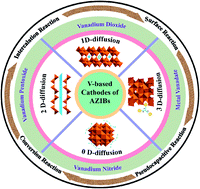Vanadium-based cathodes for aqueous zinc-ion batteries: from crystal structures, diffusion channels to storage mechanisms
Abstract
Aqueous zinc ion batteries employing metallic zinc anodes and aqueous electrolytes are highly attractive electrochemical energy storage devices owing to their cost effectiveness, intrinsic safety, elemental abundance and competitive gravimetric energy density. Compared with other cathode materials, vanadium-based compounds feature advantages such as higher capacity, higher power density and longer cycle life. Here, a comprehensive review is presented on recent advances of vanadium-based cathodes, focusing on the correlation between the structures and electrode performances as well as energy-storage mechanisms. The structure and electrochemical properties of vanadium-based cathode materials are discussed by categorizing Zn2+ diffusion channels including one-dimensional tunnels, two-dimensional planes, three-dimensional interpenetrating networks and zero-dimensional diffusion channels. Furthermore, the remaining issues of vanadium-based cathodes are highlighted and promising performance-enhancement strategies are overviewed from aspects such as lattice control, vacancy/defect engineering, and pre-intercalation of cations and/or molecules.



 Please wait while we load your content...
Please wait while we load your content...